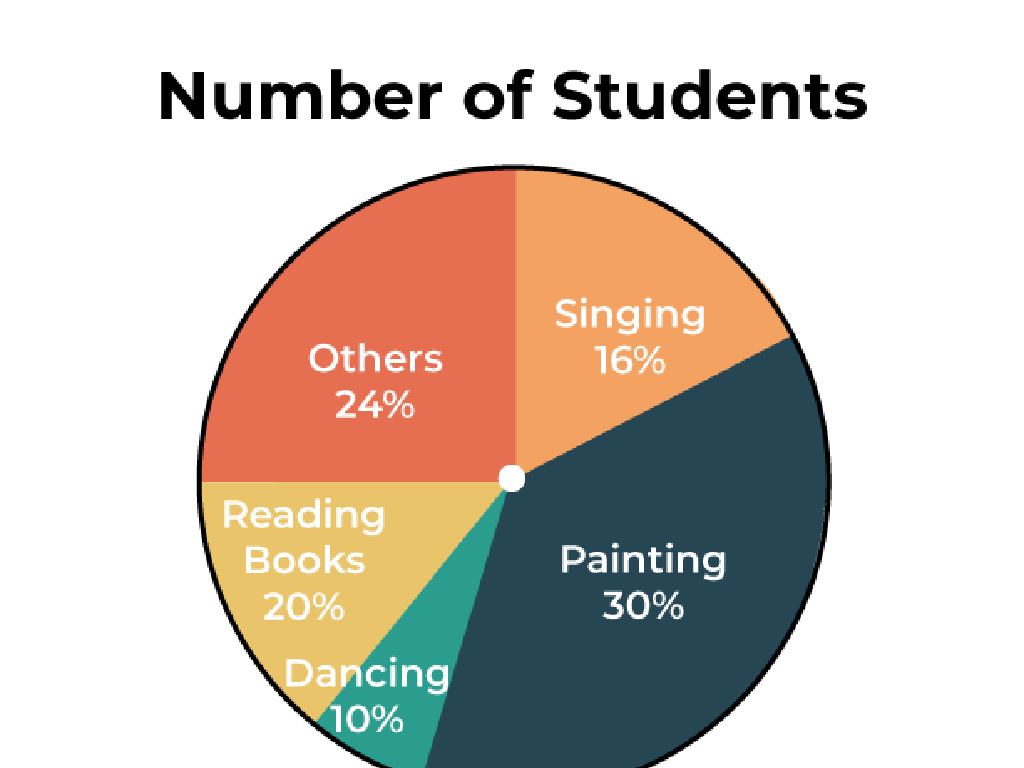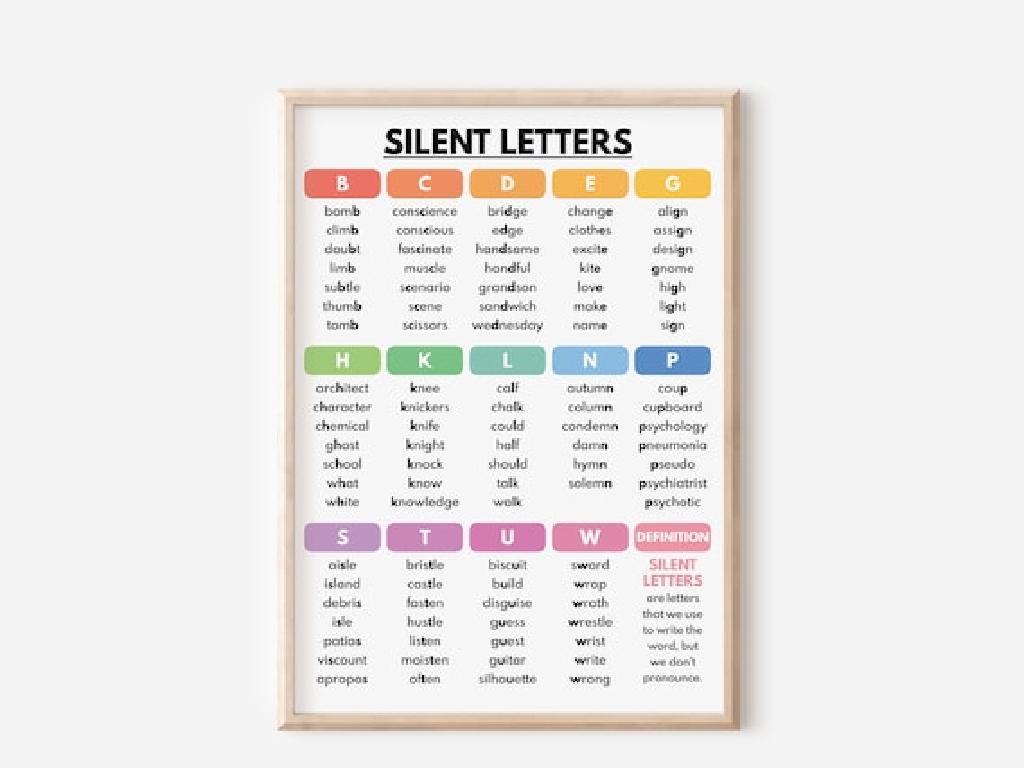Show Character Emotions And Traits
Subject: Language arts
Grade: Fifth grade
Topic: Descriptive Details
Please LOG IN to download the presentation. Access is available to registered users only.
View More Content
Exploring Character Emotions and Traits
– Understanding story characters
– Characters are the people or animals in stories.
– Defining emotions and traits
– Emotions are feelings; traits are personality features.
– Significance in storytelling
– They make characters relatable and stories interesting.
– Examples in popular tales
– Harry Potter: brave, Hermione: intelligent, Simba: courageous.
|
This slide introduces the concept of character emotions and traits, which are essential for creating depth in storytelling. Emotions refer to the feelings characters experience, such as happiness, sadness, or anger. Traits are the distinguishing qualities or characteristics of a person, like honesty, bravery, or curiosity. Discussing these aspects helps students understand and relate to the characters, making reading a more engaging experience. Use examples from well-known stories to illustrate how different emotions and traits influence the characters’ decisions and the plot’s progression. Encourage students to think of their favorite characters and identify their emotions and traits to connect with the lesson.
Exploring Character Emotions
– Understanding emotions
– Emotions are feelings like happiness or sadness
– Examples of emotions
– Happiness, anger, sadness, excitement, fear, etc.
– Identifying emotions in stories
– Look for descriptive words, actions, and dialogue
– Discussing character feelings
– Why do characters feel the way they do?
|
This slide aims to help students understand the concept of emotions and how they are portrayed in literature. Begin by explaining that emotions are feelings experienced by everyone, including characters in stories. Provide examples of basic emotions and ask students to share their own experiences with these feelings. Teach students to identify emotions in a story by looking for descriptive details, such as the words used to describe a character’s actions, thoughts, and dialogue. Encourage them to think about why a character might feel a certain way in the context of the story. This will enhance their ability to empathize with characters and improve their comprehension of the narrative.
Exploring Character Traits and Emotions
– Define character traits
– Traits are qualities or features of a character
– Examples of character traits
– Kindness, bravery, honesty, or being sneaky
– Emotions vs. Traits
– Emotions are feelings, traits are lasting qualities
– Understanding characters
|
This slide introduces the concept of character traits, which are the qualities or features that make up a character’s personality. Provide examples of traits such as kindness, bravery, and honesty, and contrast them with emotions, which are temporary feelings characters experience. Emphasize that traits are consistent and enduring aspects of a character, while emotions can change from moment to moment. Encourage students to think of characters from books they’ve read and identify their traits and emotions. This will help them understand characters more deeply and improve their descriptive writing skills.
Show, Don’t Tell: Bringing Characters to Life
– Understanding ‘Show, Don’t Tell’
– It means describing scenes so readers can see and feel them.
– ‘Telling’ vs. ‘Showing’: Examples
– ‘Telling’: Bob was mad. ‘Showing’: Bob clenched his fists, his face red.
– The power of ‘Showing’ in stories
– ‘Showing’ provides a vivid picture, making readers feel part of the story.
– Practice ‘Showing’ character emotions
|
This slide introduces the concept of ‘Show, Don’t Tell,’ a technique used to make writing more immersive. Explain that ‘telling’ simply informs the reader, while ‘showing’ allows them to experience the story through actions, senses, and feelings. Use examples to illustrate the difference, such as a character’s emotions being ‘told’ directly versus ‘shown’ through their actions or expressions. Emphasize that ‘showing’ helps readers connect with the characters and enhances the strength of writing. Encourage students to practice by rewriting ‘telling’ sentences into ‘showing’ ones, focusing on character emotions and traits.
Describing Characters in Detail
– Use sensory details for description
– Describe using sight, sound, touch, taste, smell
– Show traits through actions
– Actions speak louder than words. What do they do?
– Practice with a known character
– Pick a character from a story we’ve read and describe them
|
When describing characters, encourage students to use sensory details to make their descriptions vivid and engaging. Discuss how a character’s actions can reveal their personality traits and emotions. For practice, have students choose a character from a story they are familiar with and write a detailed description using sensory details and observed actions. This exercise will help them understand how to show, not just tell, in their writing. Provide examples and guide them through the process, ensuring they grasp the concept of using descriptive details effectively.
Creating Characters with Emotions and Traits
– Invent your own character
– Describe their emotions and traits
– Is your character brave, shy, or curious? How do they react to challenges?
– Use ‘Show, Don’t Tell’ technique
– Instead of saying ‘John is brave’, write ‘John marched towards the spider, his chin high’
– Write a short character sketch
|
This slide introduces a writing exercise aimed at developing descriptive writing skills. Students are tasked with creating an original character and describing them by showing their emotions and traits rather than just telling. For example, instead of saying ‘Sally is sad’, they could write ‘Sally’s eyes brimmed with tears as she looked at the sky’. Encourage students to think about how emotions and traits can be expressed through actions, dialogue, and body language. This exercise will help students understand the ‘Show, Don’t Tell’ technique, which is crucial for engaging writing. Provide guidance on creating a character sketch that includes physical description, behavior, and reactions to different situations.
Class Activity: Emotion Charades
– Act out various emotions and traits
– Guess portrayed emotions and traits
– Discuss body language’s role
– How does posture or facial expression show feelings?
– Reflect on the activity
– Think about what you learned from this game.
|
This activity is designed to help students understand how emotions and traits can be expressed through body language. Divide the class into small groups and have each student take turns acting out an emotion or trait without using words, while the others guess. After each round, facilitate a discussion on how certain body movements or facial expressions helped them guess correctly. Encourage students to be expressive and to pay attention to the details of their classmates’ portrayals. This will enhance their ability to describe characters’ emotions and traits in their writing. Possible emotions and traits to act out could include happiness, anger, bravery, or curiosity. This exercise will also aid in developing empathy and observational skills.
Wrapping Up: Character Emotions & Traits
– Recap: Emotions & Traits
– Remember, characters feel emotions just like we do.
– Why Descriptive Details Matter
– Descriptive details make stories come alive.
– Homework: Craft a Short Story
– Include clear emotions and traits for your characters.
– Share Your Stories Next Class
– Get ready to present your story to the class!
|
As we conclude today’s lesson, remind students of the importance of showing a character’s emotions and traits through descriptive details. This not only helps readers connect with the characters but also enhances the storytelling. For homework, students should write a short story focusing on creating vivid character descriptions that show their emotions and traits. Encourage creativity and the use of new vocabulary learned. In the next class, students will have the opportunity to share their stories, which will help develop their public speaking skills and allow them to see how their peers approached the assignment.






